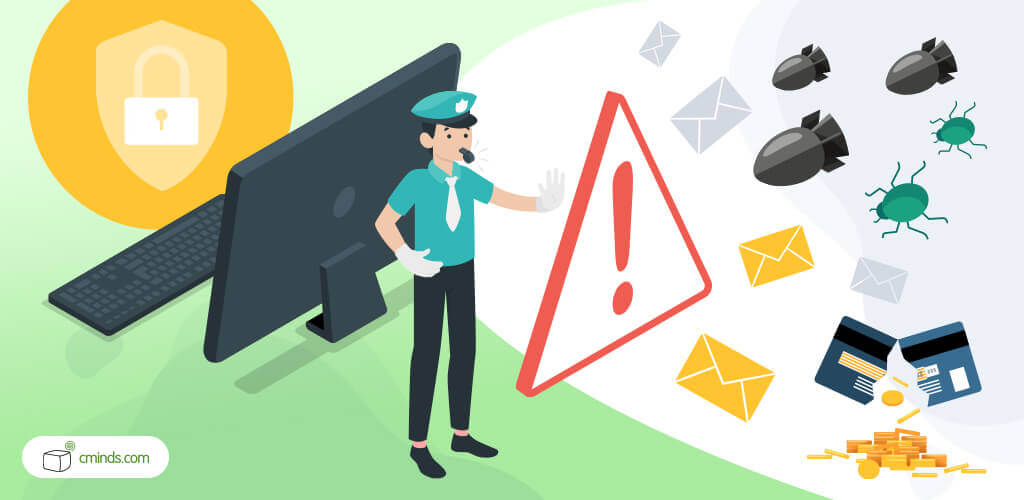Spam is the threat every WordPress site owner needs to address sooner rather than later. From annoying comment spam to potentially harmful form submissions, spam can disrupt the user experience and even jeopardize the security of your website.
In this blog post, we’ll explore a number of strategies, techniques, and tools to help you fortify your WordPress site against the relentless onslaught of spam.

WordPress and Spam
The beauty of having a WordPress website is that anyone around the world can access your content. However, this can have its downsides too.
While you strive to attract new customers through search engines and social sharing, it’s important to acknowledge the possibility of another kind of visitor: spammers.
Spammers, whether individuals or groups, aim to exploit your website with malicious intent. Their efforts may include attempting to gain unauthorized access to your website.
April 2024 Offer – For a Limited Time Only:
Get WordPress Email Registration Blacklist Plugin for 15% off! Don’t miss out!
How to Fight With Different Types of Spam in WordPress
It’s important to note that many spammers are bots, which perform tasks automatically all over your website. Let’s now go over the most common types of spam attacks.
Comment Spam
Comment sections are a popular target for spammers looking to exploit the engagement on your WordPress blog. Comment spam involves the posting of irrelevant or promotional content with the intention of either driving traffic to external sites or compromising your site’s integrity.
To combat this, consider implementing comment moderation and utilizing anti-spam plugins that can filter out suspicious comments.
Trackback and Pingback Spam
Trackbacks and pingbacks are WordPress features designed to notify you when other sites link to your content. However, spammers often misuse these features to create fake notifications, leading to an influx of irrelevant links.
To mitigate this, disable trackbacks and pingbacks or use plugins that provide better control over these notifications.
Registration Spam
WordPress sites with user registration capabilities are susceptible to registration spam. Spammers may create fake accounts, jeopardizing your site’s user database.
Employing strong CAPTCHA systems during the registration process and employing user moderation can help curb registration spam.
Some spammers create multiple fake user accounts, all originating from a single suspicious domain. To strengthen your defenses even further you should integrate a domain blacklist plugin into your WordPress site.
With this feature, you’ll prevent registration from specific domains and reduce the chances of spammers taking advantage of these access points.
Email Spam via Contact Forms

Contact forms are essential for communication but can also be exploited for spamming. Spammers may use contact forms to send unsolicited emails or promote their products/services.
Implementing validation checks and utilizing form plugins with built-in security features can help safeguard against email spam.
By utilizing a WordPress email blacklist plugin, you gain the ability to designate specific email addresses that are prohibited from filling out forms on your website.
Together with a free suspicious domain list from SpamAssassin, which can be used to filter blacklisted domains, and the ability to import any number of emails for blacklisting through a CSV file, you’ll greatly enhance the overall security of your site, promoting a safer and more trustworthy online environment.
Content Scraping and Spinning
Content scraping involves the unauthorized copying of your website’s content, while content spinning is the process of creating variations of that content. Spammers may use these techniques to create duplicate content for SEO manipulation.
Regularly monitor your site’s content for plagiarism and consider employing copyright protection tools.
Top Tips to Stop Spam on WordPress Websites

Here are some actionable ways that you can combat spammers and stop spam on WordPress.
Start Moderating Comments
As a WordPress site owner, you want people to comment and interact with your content. That’s why it’s important to learn how to differentiate between real comments, left by your users, and those created by spambots or just spammers.
Comments created by human spammers are typically poorly written and contain links directing to websites that might extort the data of those who enter them. Managing such comments can be challenging, as humans can easily bypass reCaptcha.
These comments have the potential to significantly impact your website’s optimization and page rank, underscoring the importance of addressing them as soon as possible.
The most straightforward but also time-consuming method is to moderate your comment section.
It’s as easy as going into your WordPress settings and turning on comment moderation. This will make it impossible to publish a comment without admin approval. Each comment requires manual approval, ensuring that spam comments cannot bypass the system.
In case the number of comments exceeds the time you can spend on moderating activities, consider using a plugin. Spam comment plugins automate the moderation process, eliminating the need for manual intervention.
Additionally, they can block suspicious access requests to your website and enable administrators to establish an email registration blacklist for users attempting multiple spam entries.
Integrate reCaptcha Verification

reCaptcha is a technology that allows websites to distinguish between bots and humans.
CAPTCHA stands for Completely Automated Public Turing Test to Tell Computers and Humans Apart – isn’t this the most creative acronym you’ve ever seen?
The majority of people are familiar with reCAPTCHA. It’s most often presented as a compact box with a checkbox accompanied by the “I am not a robot” statement.
You may also have seen tests that prompt you to recognize specific objects, such as stoplights, cars, or fire hydrants, that ask you to click on all the squares that contain a given object.
Employing reCaptcha tests is an effective strategy to protect your WordPress site from bots since they find it challenging to select objects on blurry images or can’t do it at all.
With each test becoming progressively more difficult, reCaptcha serves as a great filter measure, ensuring that only people can interact with your content.
Remove Website URLs and Disable Comments
A great number of comment forms feature a URL field, which is an invitation to spammers to insert malicious content links into them. By disabling URLs in your comments, you can effortlessly eliminate this vulnerability and create a more challenging environment for spammers attempting to include their content.
Media attachments such as images enhance the overall appeal of your WordPress website, but unfortunately, they attract spammers as well. When an image is linked to an attachment page, these pages often permit comments.
That’s why it is crucial to deactivate comments on media attachments through the WordPress settings to limit spam.
Additionally, you should turn off HTML comments in the backend to avoid hidden spam links. Set a minimum and maximum comment length to prevent short one-word comments or excessively long and unreadable text, effectively limiting spam on your WordPress site.
Stop Spam in a Few Simple Steps: Conclusion

These are the easy and fast methods to prevent spammers from dominating your comment sections or even your entire WordPress site.
Spam is not just bothersome; it can significantly impact your search rankings, that’s why it’s crucial to stay vigilant and take proactive measures against it rather than act after it becomes an issue.
With comment moderation, you can delete any comments identified as spam and stop them from appearing on your WordPress site. You can efficiently remove them in batches from the backend of your website.
Moreover, you can always recover any valid comments that were wrongly classified as spam or simply removed by mistake.
Aside from the tools WordPress provides, a blacklist or an anti-spam plugin can be an excellent investment to rid your website of spam, and there are many different kinds out there.
There are plugins in WordPress designed specifically for handling comment spam, while others prioritize preventing spam bots from accessing your login process. Dealing with spam is a significant concern for WordPress websites, making it advisable to select an anti-spam plugin that suits your needs.


